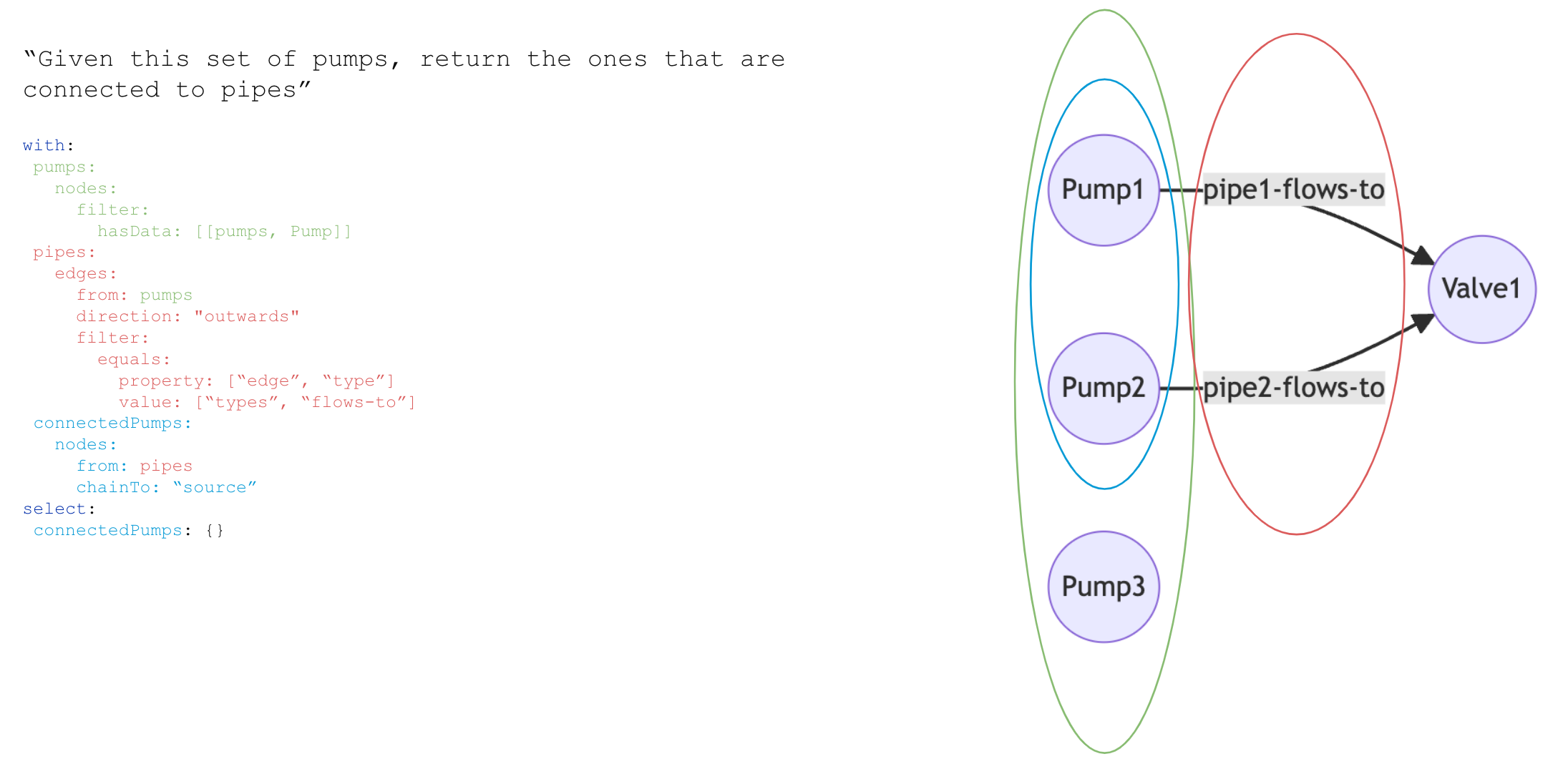/query- graph query to retrieve instances matching a query./sync- graph query to retrieve instances matching a query that have changed since the previously issued cursor./search- retrieve instances matching full-text search queries./aggregate- aggregate instance data.
/byids and /list, provide simpler
interfaces building on the /query endpoint.
The query interface supports a wide array of features.
- Advanced filters
- Parameterization
- Recursive edge traversal
- Chaining of result sets
- Granular property selection
- Subscribing to changes
How to define a graph query
You can use a query in both the/query and the /sync endpoints.
Queries are composed of:
- A
withsection defining result expressions that describe which instances to retrieve. - A
parameterssection with optional parameter substitutions if the query is parameterized. - A
selectsection that defines which properties to return as part of the result.
Result expressions
Result expressions appear directly belowwith in a query, and define a set of either nodes or
edges. You can use the set to return results, as stepping stones to derive other sets from, or both.
Result expressions are named and can be chained.
A result expression can also define sort order and a limit. See sorting for more details.
Result expressions can relate to each other via chaining, but they don’t have to. You can query for unrelated items in the same query, but you’ll generally use different sets to power graph traversals.
A set either queries nodes or edges, possibly recursively.
All fields:
nodes: An object to specify a result set of matching nodes.edges: An object to specify a result set of matching edges.sort: A list of sort configurations.limit: How many nodes or edges to return in the result. Default: 100.
Pagination
The max limit you can set for any result expression is 10,000. To retrieve the entire result set, queries accept acursor object mapping result sets to cursors. Pagination cursors in the nextCursor object are emitted for each result set, allowing you to page through everything.
You can’t combine pagination cursors with custom sorts, unless they are backed by a cursorable index. If no pagination cursor is present for a given result expression in the response, there is no more matching data.
Node result expressions
Anodes statement in your result expression makes the set contain nodes.
A node result expression can be chained off an optional node or edge result expression.
When chaining off another node result set, you’ll retrieve the nodes pointed to by a direct relation property. The direct relation property is defined using the through field.
When chaining off an edge result set, you’ll retrieve the end nodes defined by the edges in the set.
from: an optional result expression to chain from.filter: restrict which nodes to return in the result set.through: required whenfromis a node result expression. Specify a direct relation property to traverse.direction: applicable whenthroughis defined. Specify which direction to traverse the direct relation.chainTo: applicable whenfromis an edge result expression. Control which side of the edges infromto chain to. The behavior depends on thedirectionsetting in thefromresult expression:- If
fromfollows edges outwards,direction="outwards"(default), then"source"selectsstartNodeand"destination"selectsendNode. - If
fromfollows edges inwards,direction="inwards", then"source"selectsendNodeand"destination"selectsstartNode.
- If
Edge result expressions
Anedges statement in a result expression makes the set contain edges, and the statement
defines the rules the graph traversal will follow.
A graph traversal can start from an initial set, defined by from, which names another result expression.
The graph traversal follows edges in a particular direction, controlled by direction (Default: outwards.)
Bob outwards (the default), you’ll get
the edge Bob -fancies-> Mallory.
If you follow edges inwards, direction=inwards, you’ll
get Alice -is-parent-> Bob.
The traversal happens breadth-first. See limitations for more details.
A traversal is defined by what edges to follow, what nodes to match, and what nodes to terminate
the traversal at. This is controlled by filter, nodeFilter and terminationFilter:
-
filteris a filter on edges. You would typically filter on the property[edge, type], but you can filter on any property on an edge. -
nodeFilteris a node filter, which the node on the “other” side must match.-
With
direction: outwards, that means the “end node” of the edge must match. -
With
direction: inwards, the “start node” must match.
-
With
-
terminationFilteris similar tonodeFilter, except if it matches, the traversal ends. A node must also matchnodeFilter(if any) to steer the traversal to the node to terminate at in the first place.maxDistancecontrols how many hops away from the initial set traversal will go.maxDistancedefaults to unlimited (but the set must respect itslimit, defined on the result expression). IfmaxDistanceis 1, execution might be faster. If you know there will only be one level, usemaxDistance: 1.
| Option | |
|---|---|
from | Result expression to chain from. |
filter | Edges traversed must match this filter. |
nodeFilter | Nodes on the “other” side of the edge must match this filter. |
terminationFilter | Do not traverse beyond nodes matching this filter. |
maxDistance | How many levels to traverse. Default unlimited. |
direction | Whether to traverse edges pointing out of the initial set, or into the initial set. |
limitEach | Limit the number of returned edges for each of the source nodes in the result set. The indicated uniform limit applies to the result set from the referenced from. limitEach only has meaning when you also specify maxDistance=1 and from. |
chainTo | applicable when from is an edge result expression. Control which side of the edges in from to chain to. The behavior depends on the direction setting in the from result expression: - If from follows edges outwards, direction="outwards" (default), then "source" selects startNode and "destination" selects endNode. - If from follows edges inwards, direction="inwards", then "source" selects endNode and "destination" selects startNode. |
Selects
Select configurations appear directly belowselect in a query and specify which data to retrieve for the respective result expression. The configuration specifies a number of sources (views) and a property selector for each. The property selectors define which view properties to emit in the query result.
You can have sets whose properties aren’t emitted. This is useful if the sets are necessary for chaining, but can be excluded in the final results. Sets that are neither chained nor selected aren’t run, but they’ll cause a slight query processing overhead.
The results are grouped by their respective sets and contain properties that match the property selectors for the set.
Filters
Filters define what a part of the query matches. Filters are tree structures where the operator comes first and then the parameters for that operator. A simple example is thein filter:
node.name, which is a text property, is equal to any of the values in the provided list, the node will match. Properties are typed, and what query operators you can use on a property depends on its type. These are the supported filters.
Equals
Theequals filter performs exact matches
In
Thein filter matches if any of the elements in the list of values match the property.
ContainsAny
ThecontainsAny filter matches if any of the stored values matches any of the provided values. The property must be an array.
ContainsAll
ThecontainsAll filter matches if the stored array contains all the provided values. The property must be an array.
Range
Therange filter matches if the stored value is within the provided bounds. The property must be a number or timestamp.
gt (greater than), gte (greater than or equal to), lt (less than), and lte (less than or equal to).
Overlaps
Therange filter matches if the range made up of the two properties startProperty and endProperty overlap with the provided range. The properties must be numbers or timestamps.
gt (greater than), gte (greater than or equal to), lt (less than), and lte (less than or equal to).
Exists
Theexists filter matches if the stored value is not null.
Prefix
Theprefix filter matches if the stored value has the provided prefix. The property must be a string or an array.
HasData filter
AhasData filter matches if data is present in a set of containers or views.
There is an implicit AND between the containers and views referenced in the filter, and the filter matches only if the node or edge has data in all the specified containers and views.
When you specify a container, the filter matches if the instance has all required properties populated for the container.
When you specify a view, the filter matches nodes with data in all the containers that the view maps. If the view has an explicit filter defined, that filter is used instead.
The following example matches instances that have data in both the container my_space.my_container and the view my_space.my_view.v1:
hasData filter behaves differently based on the view’s configuration:
-
No explicit filter on the view: The
hasDatafilter checks that data exists in all containers the view maps from. The filter matches if there is data inmy_space.my_container AND (my_space.c1 AND my_space.c2). -
Explicit filter on the view: The
hasDatafilter uses the view’s filter instead. The filter matches if there is data inmy_space.my_containerand the data satisfies the conditions defined inmy_space.my_view.v1.filter.
Nested
Use anested filter to apply the filter on the node pointed to by a direct relation. scope specifies the direct relation property you want use as the filtering property.
Instance references
TheinstanceReferences filter matches instances with fully qualified references (space + externalId) equal to any of the provided references.
Compound filters
You can combine filters withand, or, not:
(NOT node.type in ('movie')) AND imdb.movie.released >= $start.
Parameters
You can use parameters for values in filters. The parameters are provided as part of the query object, not in the filter itself. This filter is parameterized:start parameter. The parameter must be compatible with all the types and operators that refer to the parameter. In the above example, the “released” property is a date, and the start parameter must be compatible with the date type. Otherwise, the query will fail, even if the range filter is optional because it’s OR-.ed
Sorting and limiting
Sorting and limiting can happen in different places in a query:- In the result expression, that is, in the
withobject that defines a node or edge set. - In the result selection, that is, under
selectwhere you can define sets to emit as results.
with transitively affects dependent sets. If you only change the sort order of a with expression, dependent sets will not (necessarily) change (based on how the dependent sets are defined). If you, however, put a limit on an expression, all dependent sets will inherit the limit and consequently change. This is also true for sets that aren’t emitted via select, that is, for sets that are only defined as stepping-stones for other sets.
Sorts and limits defined under select change the result appearing order for that set only, not for dependant sets.
This example query would let some_edges and target_nodes pull from the full amount of nodes in some_nodes, even if what’s returned as a result for some_nodes is capped at 100:
Order of sorting and limiting
A limit in an edge traversal applies to when to start traversing, which happens before sorting.
edges, the limit applies to how many edges to discover. This may not be all the edges that could be discovered in a full traversal. If you start traversing from some node and ask for 100 edges sorted by creation timestamp, the 100 edges discovered before the traversal stops get sorted. The full graph is not traversed to find the 100 newest edges in the graph defined by the traversal filters.
To sort with a recursive graph traversal, you’ll need to specify the sort configuration via postSort.
An edge traversal with maxDistance=1 can take a standard sort configuration.
Syncing - subscribing to changes
The/sync endpoint lets you subscribe to changes on instances, matching an arbitrary filter. The interface for the /sync endpoint is largely similar to the /query endpoint but differs in a few ways:
- It always returns a value for
nextCursor. - It returns instances that have changed since the provided cursor.
- It returns soft-deleted instances until they have been hard-deleted. These will have a
deletedTimeproperty set to a non-null timestamp value. Read more about soft deletion here. - Cursors from
/syncare valid for a soft deletion grace period, three days by default. - A cursor older than the soft deletion grace period (3 days) may not pick up all changes, especially the deletions.
- If the cursor is too old, you must restart the sync or set
allowExpiredCursorsAndAcceptMissedDeletestotrue(see #allowing-the-use-of-outdated-sync-cursors).
/sync endpoint to subscribe to changes. You’ll pull everything once and then keep that state updated incrementally. The Python SDK documentation has an example of how to do this.
The endpoint also enables you to sync a subgraph into memory and then use libraries like NetworkX to perform various specialized graph analysis tasks on live data.
You can also use the endpoint to keep specialized dashboards up to date by syncing out all data about a data model.
Sync modes
There are some performance pitfalls when combining sync with filters. The system cannot easily make use of indexes while determining which instances have changed since the sync started. Therefore, the default way of syncing may not be performant if using filters other than a single space filter. Also, sorting is not supported while syncing because any sort would conflict with the order of yielding new changes. Before the sync endpoint yields new changes, it backfills the data that existed before starting the sync. The system needs to scan through all the data to determine which data matches the provided filter. You can use themode parameter to control the backfill phase:
onePhase(default): Don’t distinguish between the backfill phase and subsequent changes. Use this mode if you sync without a filter or with a single space filter.twoPhase: Split the sync into two stages. This allows the system to take advantage of an index, either the default index or a custom cursorable index, in the backfill stage. This should be used if syncing with e.g. ahasDatafilter. If you want to use a custom cursorable index, you can provide thebackfillSortparameter which must match the sort of the desired cursorable index.noBackfill: Skip the backfill stage and yield only instances that have changed since the sync started.
Allowing the use of outdated sync cursors
Sync cursors will expire after 3 days. This is because soft-deleted instances are cleaned up after this grace period, so a client using a cursor older than that risks missing deletes. If theallowExpiredCursorsAndAcceptMissedDeletes flag is set to true, the API will allow the use of expired cursors.
Limitations
Graph traversal
Any query that involves a graph traversal will force nested loop-style execution. This will work well enough for traversals limited to a few hundred thousand unique paths. The graph traversal is breadth-first, and all possible paths are traversed. This is especially important to keep in mind with traversals across loops. For example, a query that follows all the possible paths of a fully connected graph will likely be terminated due to constraints on either time, memory, or temporary disk usage.Timeout errors
Queries get canceled with a408 Request Timeout error if they take longer than the timeout. If you hit a timeout like this, you must reduce the load or contention or optimize your query.
Reverse direct relations targeting lists can’t be traversed using the graph query endpoint
You can’t traverse reverse direct relations which target lists of direct relations—reverse direct relations withtargetsList=true—using the /query endpoint. You must use the /search endpoint instead.
Let’s say you have an Activity with a list of direct relations pointing to nodes which have data in an Asset view. The Asset view has a reverse direct relation pointing to a set of nodes with data in the Activity view. To retrieve the activies related to an asset, you must send a request to the /search endpoint where you filter on the space+externalId combinations of those assets. For example:
Graph query examples
Simple retrieval by node.type
This is an example query to retrieve all nodes of type Pump, and all the properties on the Pump/v1 view.
Retrieve everything in a space
This is an example query to retrieve all nodes in theequipment space and retrieve the manufacturer property on the Equipment/v1 view. This query is parameterized and can be used for both the /query and the /sync endpoints.
Traverse edges to retrieve workorders related to a set of assets
This query retrieves all work orders related to the set of assets with external IDsasset1, asset2, and asset3. It traverses edges of the type relates-to that point from work orders to assets.
Traverse direct relations to retrieve the locations of a set of sites
Consider a scenario where there are two sets of nodes representing sites and locations, respectively. The sites are connected to the locations using a direct relation property. This query retrieves the set of location nodes related to a set of sites.To traverse direct relation properties performantly, make sure that the property is associated with a b-tree index.
Traverse direct relations inwards
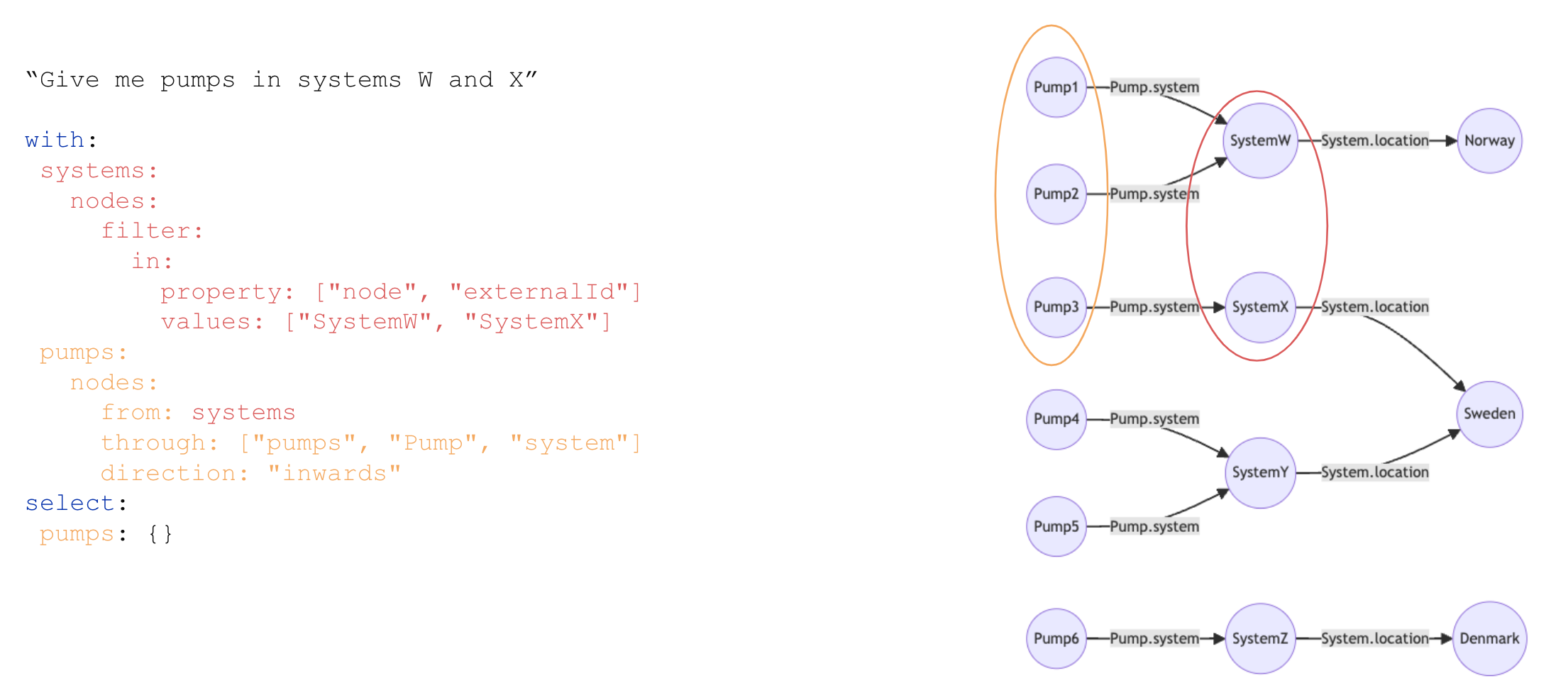
Traverse direct relations outwards
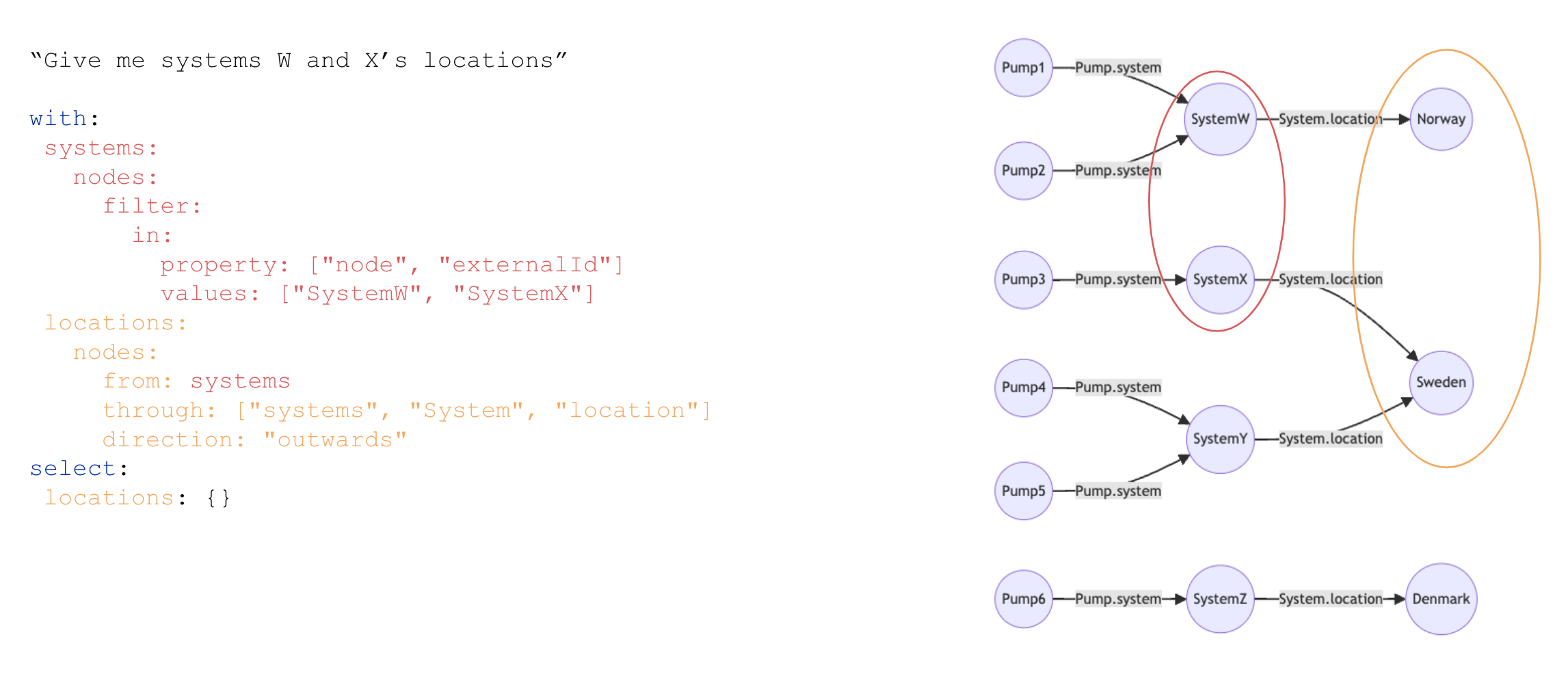
Traverse direct relations multiple levels
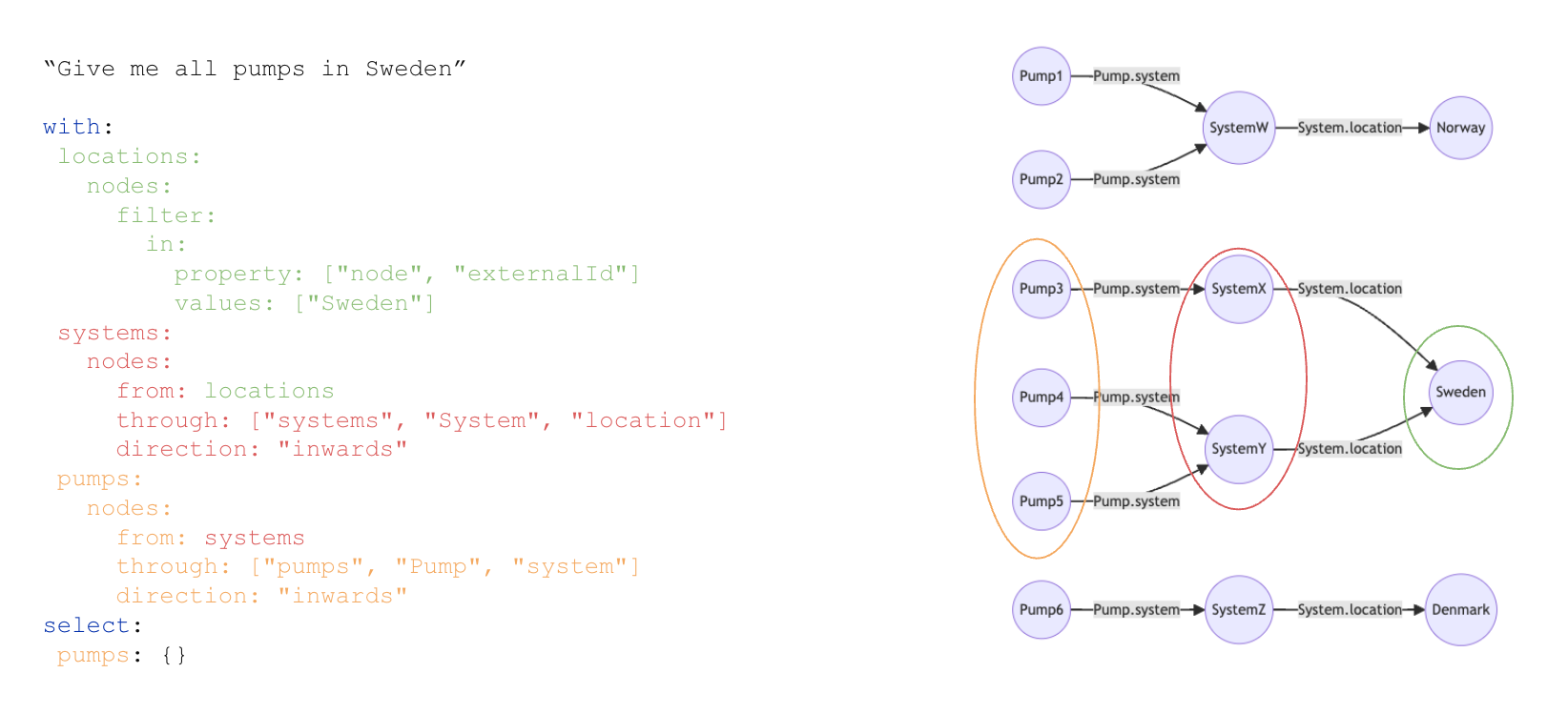
Traverse edges single hop
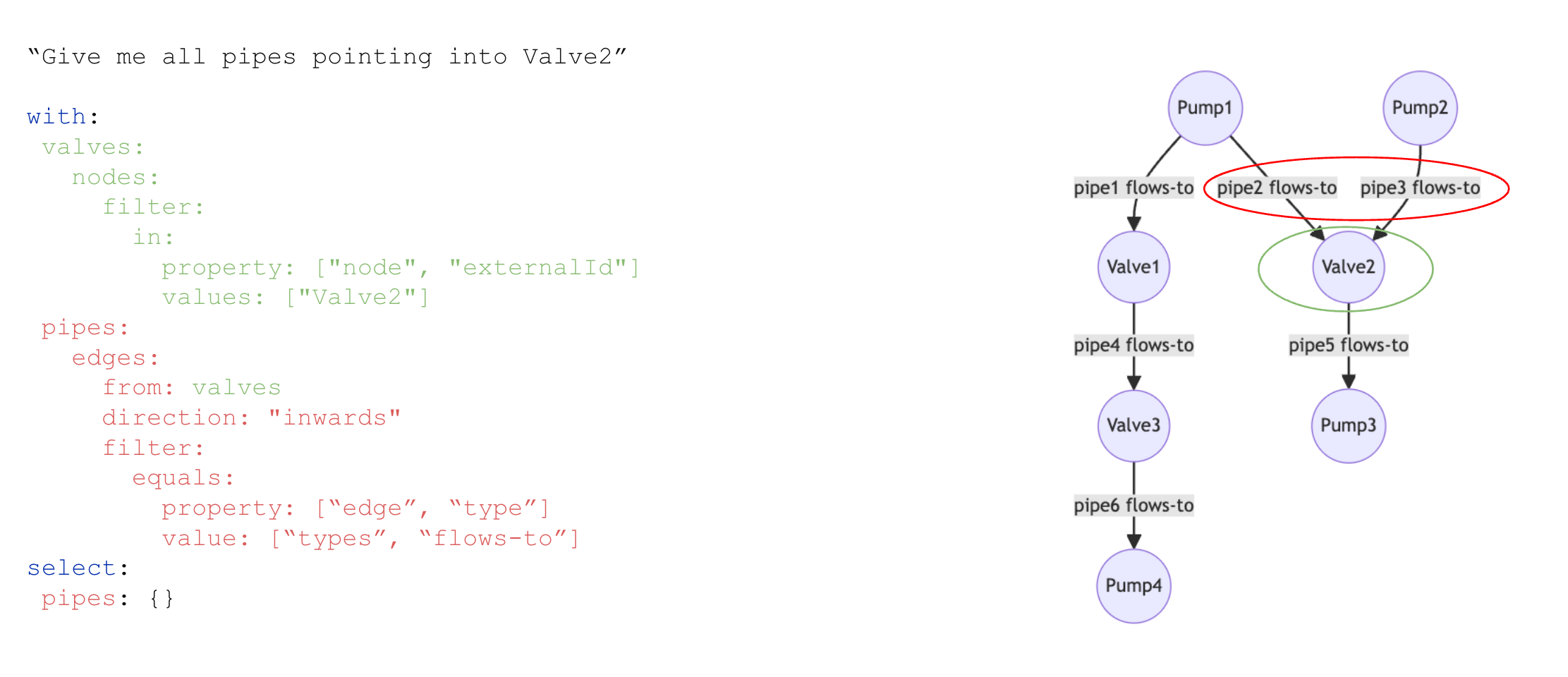
Traverse edges recursively
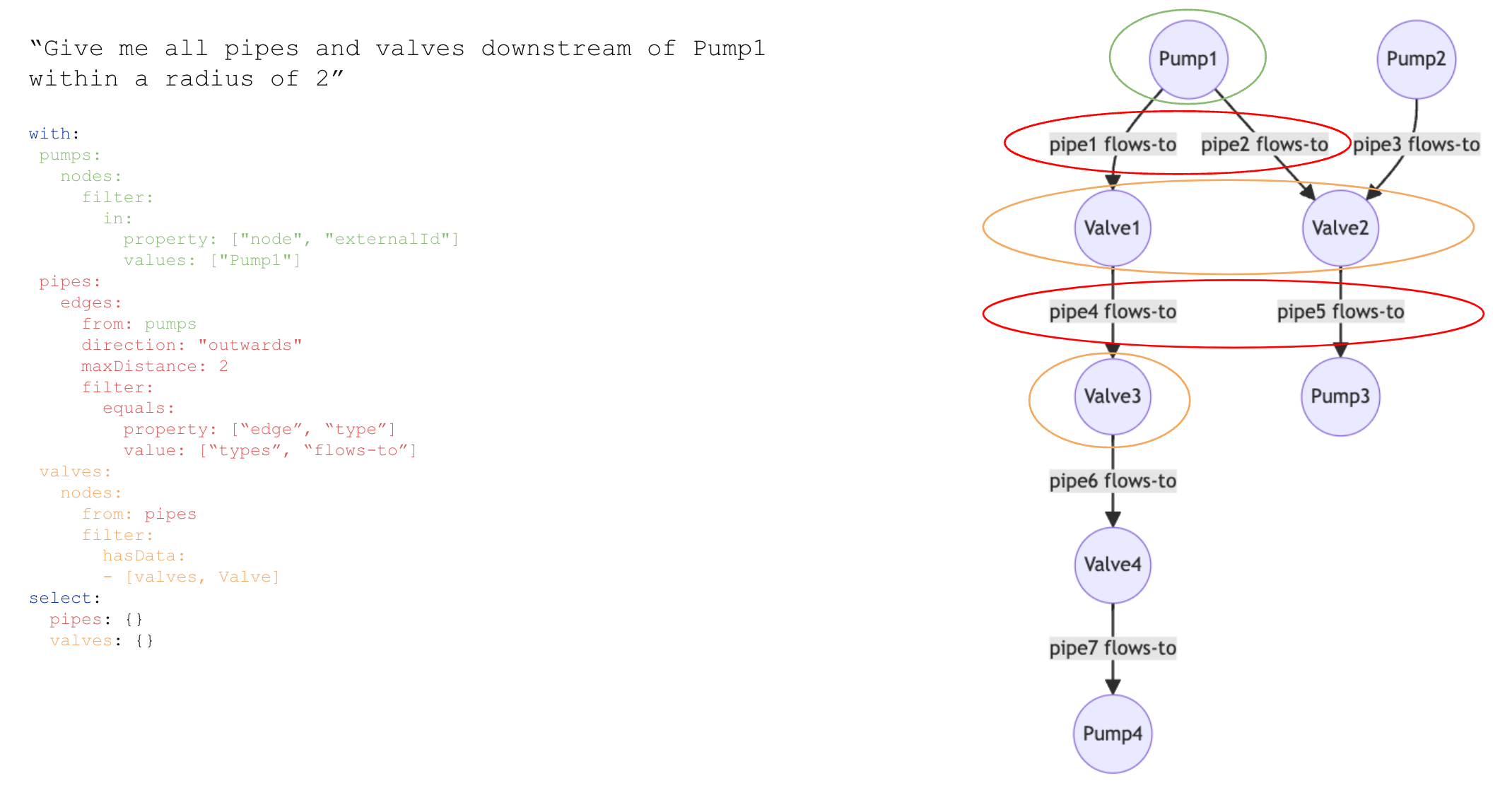
Traverse edges recursively with a node filter
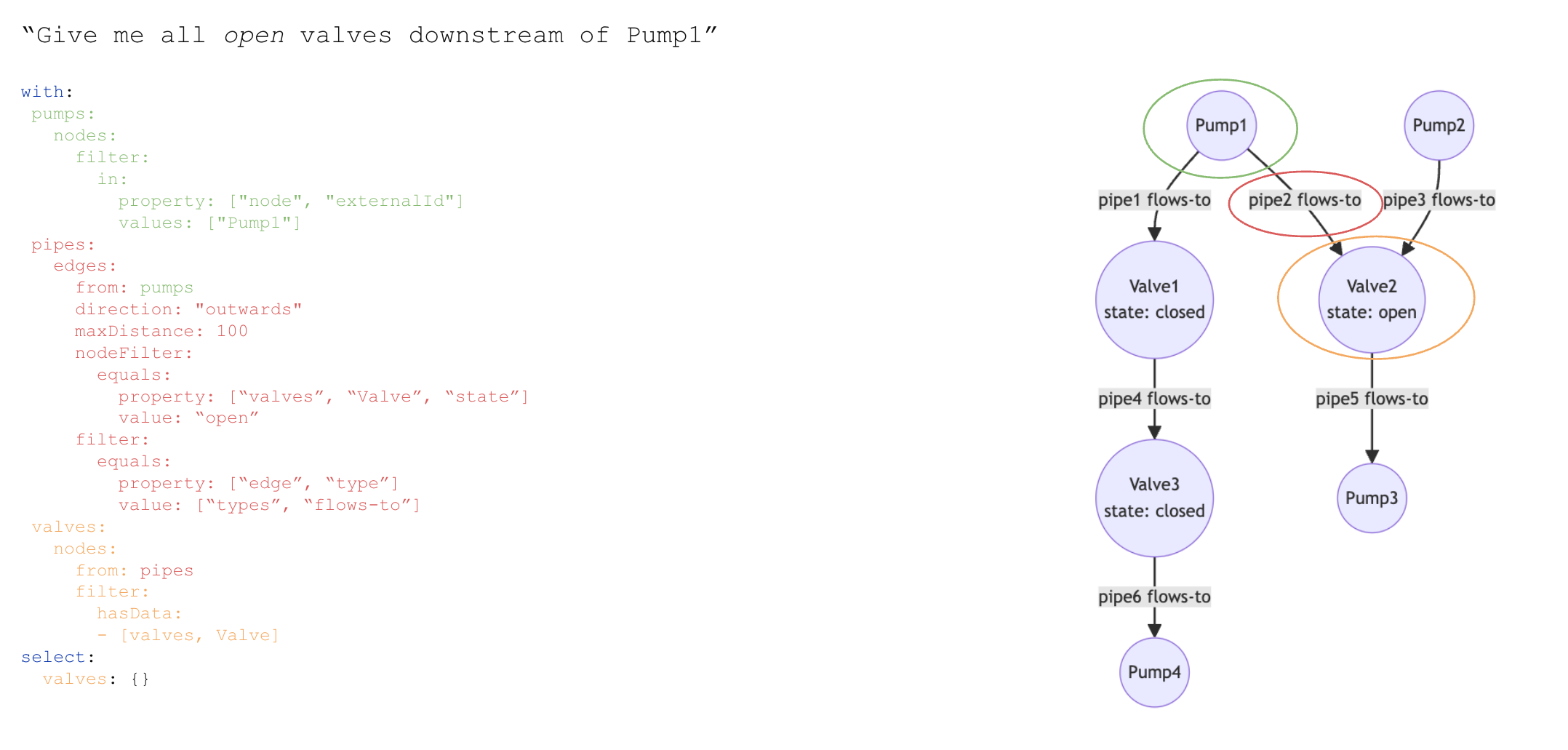
Traverse edges recursively with a termination filter
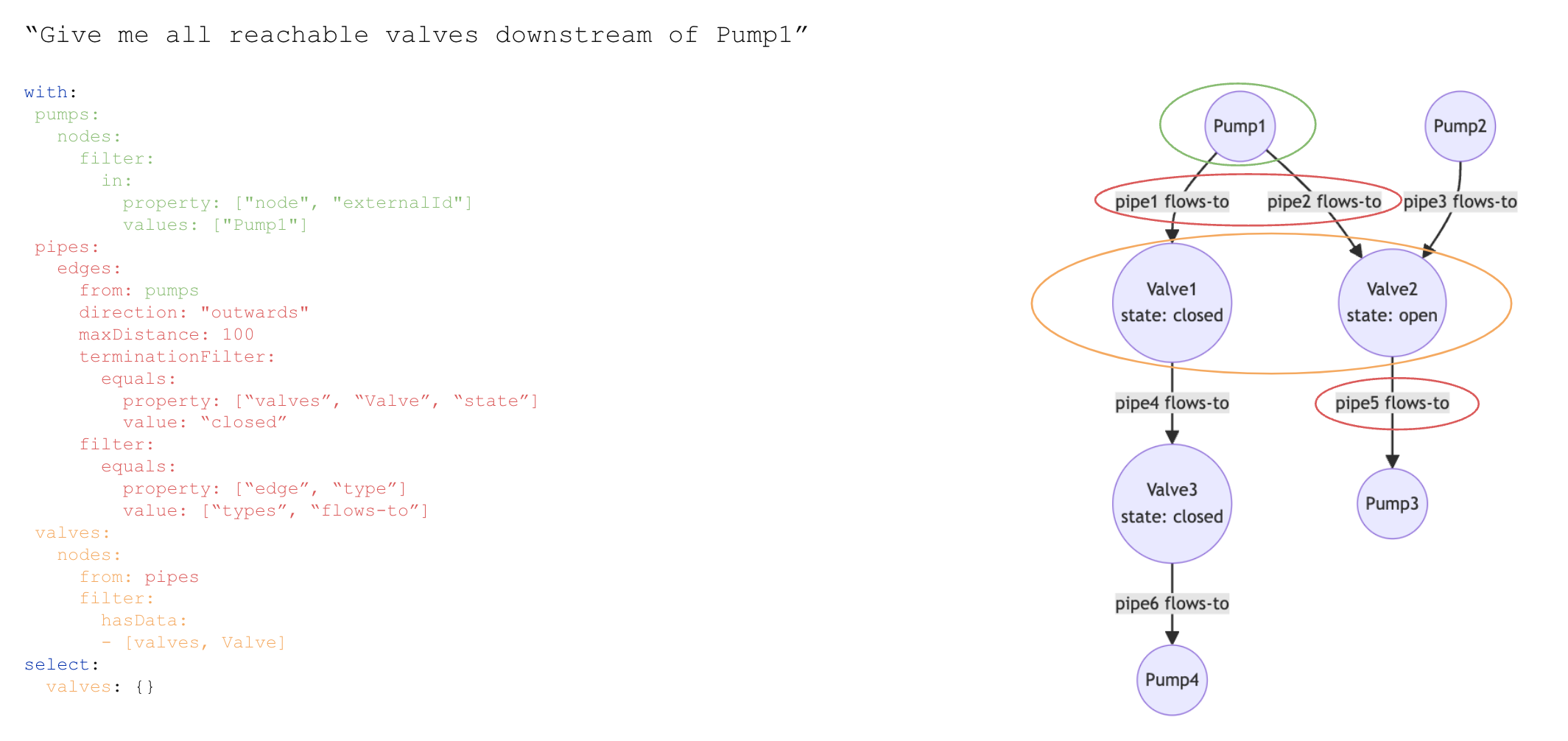
Traversing edges using the chainTo parameter
